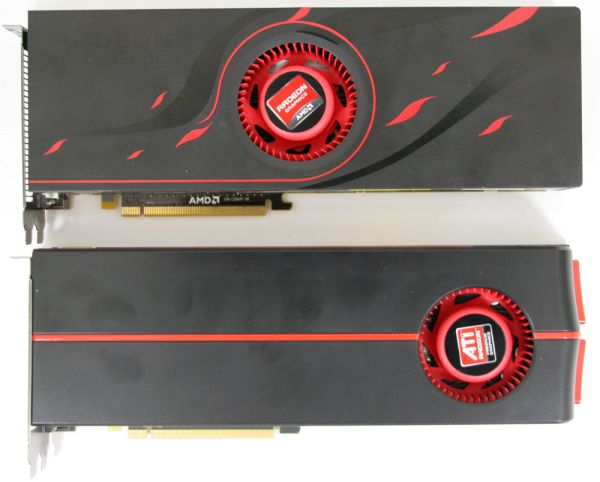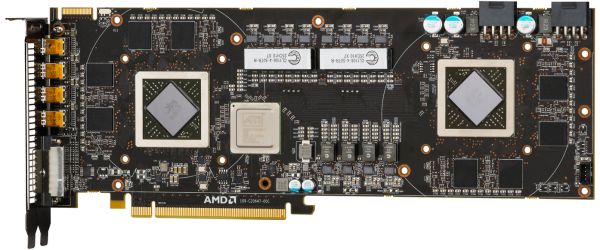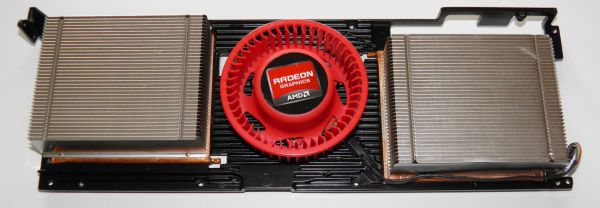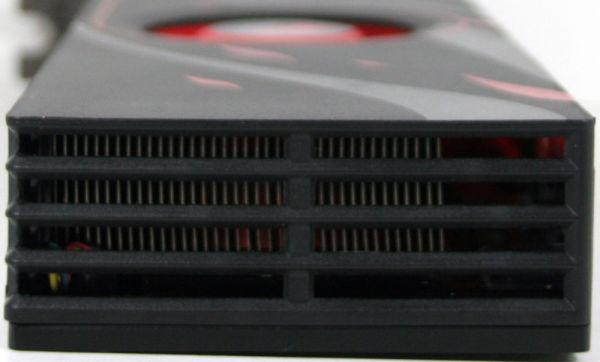AMD's Radeon HD 6990: The New Single Card King
by Ryan Smith on March 8, 2011 12:01 AM EST- Posted in
- AMD
- Radeon HD 6990
- GPUs
Meet The 6990
If you recall our coverage on the 5970, we found a few areas where AMD was lacking. The cooling on the 5970 was sufficient to run the GPUs even at 5870 clocks and voltages, however the cooling on the VRMs was lacking, leading to real world programs trigging the VRM thermal protection mechanism; and while this was within safety guidelines, it’s not a comfortable place to be for long term operation. This ultimately led to us writing off the 5970OC as a 100% reliable product, sticking to recommending the 5970 solely at stock speeds.
The design of the 6990 in turn reads very much like a response to our findings in true engineering fashion. Furthermore for the 6990 AMD not only had to take a look at the 5970’s weaknesses, but also how to handle an even greater power load. The result is that the 6990 is distinctly different from the 5970 before it.
Compared to the 5970, the 6990 is ever so slightly shorter, thanks in large part to the fact than the 6000 series casing is more squared off compared to the 5000 series’ tapered design. As a result it comes in at 11.5” for the PCB (the same as the 5970), and with casing a full 12” long compared to the 5970’s 12.16”. This means that the 6990 has effectively the same space requirements as the 5970, cooling notwithstanding.
Meanwhile it’s the fan however that is going to catch the most attention and this is where we’re going to dovetail in to cooling. The 5970’s traditional blower had its strengths and weaknesses, the strengths being that blowers are relatively forgiving about a case’s ability to exhaust hot air, and the weaknesses being that the GPU (and VRMs) closest to the fan received better cooling than the farther GPU. The VRMs proved to be particularly problematic, as they could overheat well before the GPUs did and AMD does not spin up their fans based on VRM temperatures.
Correcting for this and at the same time allowing for even greater heat dissipation, the rear blower design is out. Its replacement is a design that we’ve seen in 3rd party cards before such as the Asus ARES 5870X2, but not in a reference design: a center-mounted fan/blower with a GPU to each side. The difference is critical and indeed cannot be understated: a rear blower channels most hot air outside of the case, while a center-mounted blower effectively splits the card in two, with one GPU + supporting chips being exhausted outside of the case, and the 2nd GPU + supporting chips being exhausted inside the case. The design is still enclosed, so everything goes out either the front or back of the card while fresh air is pulled in the center.
With the replacement of the blower, so has gone the heatsink. The 5970’s single large vapor chamber + heatsink design has been replaced in favor of a segmented heatsink, further driving home the concept that the 6990 is closer to 2 video cards sharing 1PCB than it is 2 GPUs on one card. Each heatsink in turn is connected to the GPU via its own vapor chamber, resulting in the GPUs being fully isolated from each other as far as cooling is concerned.
Even the thermal paste connecting the GPUs to the vapor chambers has been changed for the 6990 – AMD has replaced traditional paste with a phase change material. Phase change materials – pastes/pads of material that melt and solidify based on temperature are nothing new, however they’re still exotic; material similar to what AMD is using is not readily available as paste is. AMD even went so far as to suggest that reviewers not directly disassemble their 6990s as it would require a new application of phase change paste in order to achieve the same efficiency as the original material. The net result of all of this by AMD’s numbers is that the phase change material is 8% better than the regular paste they’ve been using.
Rounding out our focus on cooling is the VRMs, which have been relocated in order to correct for the 5970’s limited VRM cooling capabilities. The VRMs and controllers are now at the center of the board – now they’re cooled before the GPUs or RAM modules are. The profoundness of this is twofold: not only is it an improvement on the 5970, but with the 6990’s higher power consumption VRM cooling is even more important. As with the 6970, voltage regulation is supplied by Volterra MOSFETs and controllers.
All told, while the 5970 was designed to handle and dissipate 400W of heat, the 6990 is officially designed for 450W. In practice, at its limits in our test rig this is closer to 500W. To handle and dissipate that much heat in roughly 72in3 of space is nothing short of amazing.


















130 Comments
View All Comments
ET - Tuesday, March 8, 2011 - link
If you're going to keep your case open all day with your ear to the graphics card, then you might get that 70dB+, which won't be too nice on the ear. On the other hand you won't get much gaming done. :)I don't know the exact distance Anandtech measured this noise at, but Kitguru measured at about 1 metre and got 48dB when running Furmark, 40dB for normal load.
bobsmith1492 - Tuesday, March 8, 2011 - link
70dB is very low and only would apply if you are essentially living next to your computer - that's a 24-hour exposure level.NIOSH recommends 85dB as the upper limit for 8 hours of exposure, with a 3dB exchange rate - that is, every time you halve the amount of time you're exposed to the sound you can increase the volume by 3dB.
http://www.cdc.gov/niosh/docs/96-110/appF.html
looniam - Wednesday, March 9, 2011 - link
*ahem*"The document identifies a 24-hour exposure level of 70 decibels as the level of environmental noise which will *prevent* any measurable hearing loss over a lifetime"
does NOT say what the maximum is.
from my experience as an audio tech:
95dB is the start of temporary hearing loss, 110dB is the start of permanent and 140dB is the threshold of pain.
and for drunk people, they can't hear anything below 150dB :)
Ninjahedge - Thursday, March 10, 2011 - link
What?futuristicmonkey - Tuesday, March 8, 2011 - link
Any chances for some memory OC benches?nitrousoxide - Tuesday, March 8, 2011 - link
Both AMD and nVidia are out of mind, they are ignorant of the consequence by putting two gigantic chips with 5+billion transistors on the same board. I can't find the point of buying such outrageous card instead of building a CFX/SLI system. At least the latter isn't that loud, isn't that hot and consumes hardly more power than those monstrosities.TSMC is to blame. They dropped 32nm so it is impossible to get 6990/590 within 300W power envelope. But neither AMD nor nVidia turn back, but keep making these non-sense flagship cards.
Figaro56 - Tuesday, March 8, 2011 - link
No, it's not.Amuro - Tuesday, March 8, 2011 - link
I will be water cooling them! :)nitrousoxide - Tuesday, March 8, 2011 - link
What a shame it will be when next-generation 28nm Single GPU flagships wipe out these monsters with ease while consumes half the power, running silent.strikeback03 - Tuesday, March 8, 2011 - link
That hasn't traditionally happened. Look at the comparison between the 6990 and the 4870x2 - 2 generations, IIRC one process shrink. The 6990 does generally put up much better numbers, but consumes a lot more power to do so. Looking at a comparison between the 4870x2 and 5870 (double GPU on a larger process size to next-gen single-GPU) they are very close, with the 4870x2 overall holding a slight lead. And of course none of these high-end reference cards have ever been silent